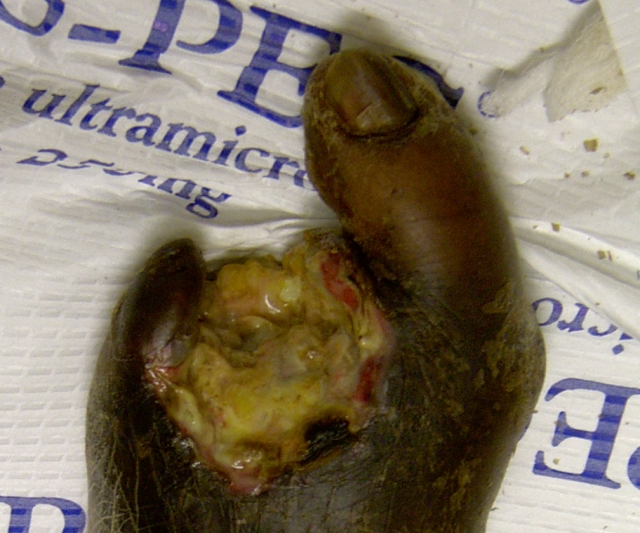Gangrene
| Gangrene | |
 | |
|---|---|
| Diabetic with severe infection and loss of toes - wet gangrene in center. |
|
Gangrene Microchapters |
|
Diagnosis |
|---|
|
Treatment |
|
Case Studies |
|
Gangrene On the Web |
|
American Roentgen Ray Society Images of Gangrene |
Editor-In-Chief: C. Michael Gibson, M.S., M.D. [1]
Etymology
The etymology of gangrene derives from the Latin word "gangraena" and from the Greek gangraina (γάγγραινα), which means "putrefaction of tissues".
Treatment
As early as 1028, when antibiotics had not yet been discovered, fly maggots were commonly used to treat chronic wounds or ulcers to prevent or arrest necrotic spread, as some species of maggots consume only dead flesh, leaving nearby living tissue unaffected. This practice largely died out after the introduction of antibiotics and enzyme to the range of treatments for wounds. Recently, however, maggot therapy has regained some credibility and is sometimes employed with great efficacy in cases of chronic tissue necrosis.
In modern times treatment is usually surgical debridement, and excision with amputation is necessary in many cases. Antibiotics alone are not effective because they do not penetrate ischemic muscles sufficiently.
See also
References
Template:Circulatory and respiratory system symptoms and signs
Template:Skin and subcutaneous tissue symptoms and signs Template:Nervous and musculoskeletal system symptoms and signs Template:Urinary system symptoms and signs Template:Cognition, perception, emotional state and behaviour symptoms and signs Template:Speech and voice symptoms and signs Template:General symptoms and signs
ar:غنغرينة bg:Гангрена ca:Gangrena cs:Gangréna da:Gangræn de:Gangrän et:Gangreen eo:Gangreno fa:قانقاریا io:Gangreno is:Kolbrandur it:Cancrena he:נמק nl:Gangreen no:Koldbrann qu:Kawsaykuq tantalli ismusqa scn:Cancrena fi:Kuolio sv:Kallbrand uk:Гангрена wa:Grangrin